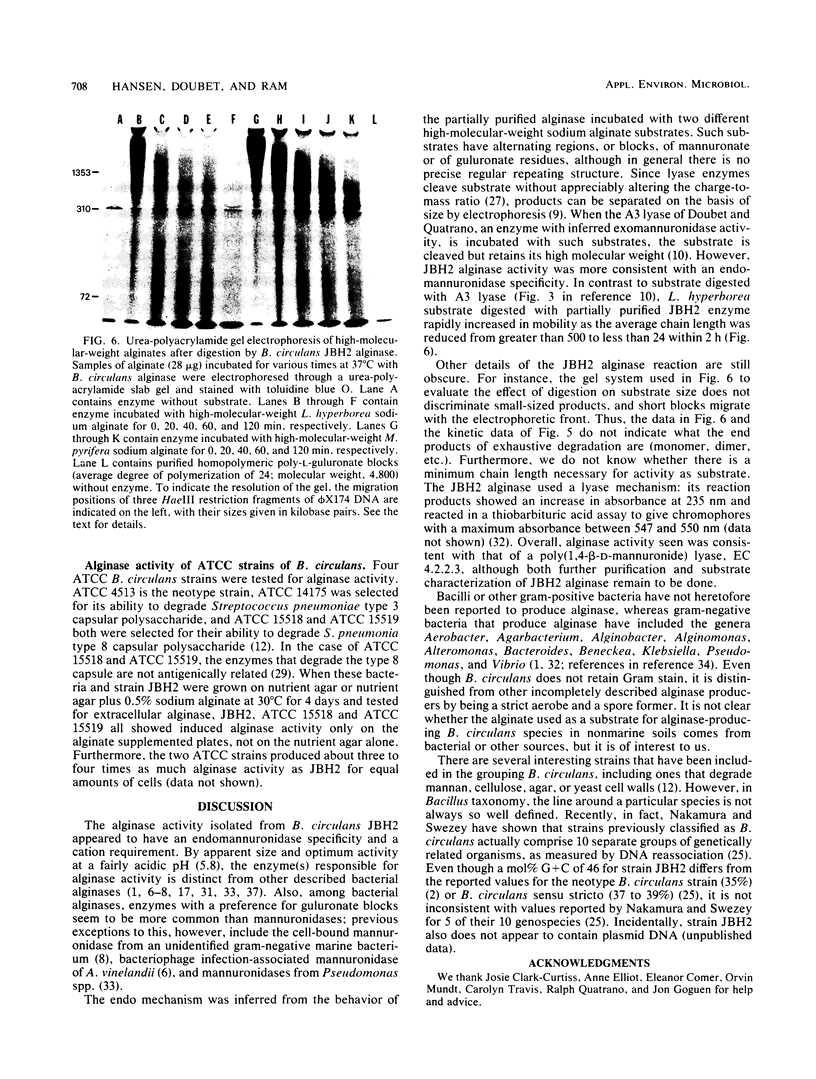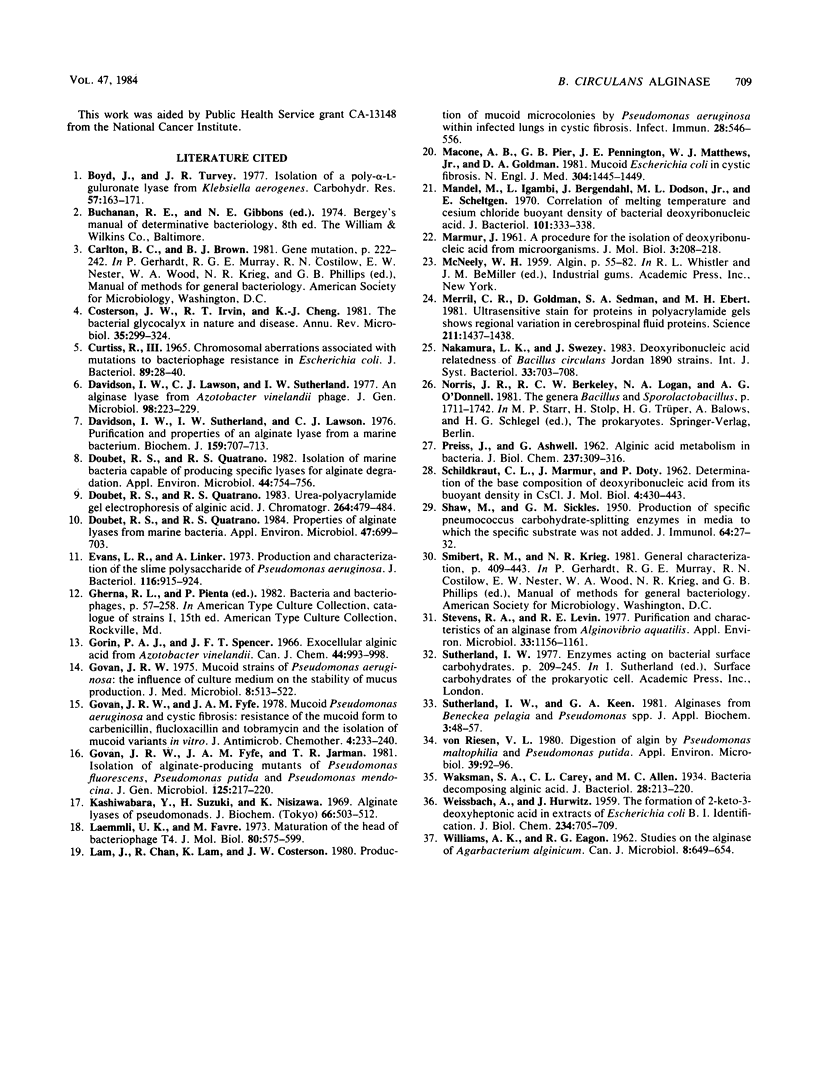Abstract
Stream and soil samples were screened for microorganisms that would use alginate from mucoid Pseudomonas aeruginosa as the sole carbon and energy source. A pure culture containing large aerobic rods was isolated. The cells were about 0.8 by 2.5 microns in size, had lateral or peritrichous flagella, had a negative Gram stain reaction, and produced spores on sporulation medium. Purified DNA was approximately 46 mol% G+C as measured by thermal denaturation. From these and other biochemical tests, the organism was identified as Bacillus circulans. The enzyme activity that degraded alginate appeared in the culture medium. Upon gel filtration, alginase activity eluted as a single peak at a position corresponding to a protein of 40,000 daltons. Activity recovered from this one-step, partial purification showed apparent endomannuronidase specificity. Like other alginases previously reported, the enzyme appeared likely to be a lyase (or eliminase). However, no Bacillus species or other gram-positive bacteria have heretofore been reported to produce extracellular enzymes with alginase activity. Several other B. circulans strains from the American Type Culture Collection also appeared to have inducible extracellular alginase activity.
Full text
PDF





Images in this article
Selected References
These references are in PubMed. This may not be the complete list of references from this article.
- Boyd J., Turvey J. R. Isolation of poly-alpha-L-guluronate lyase from Klebsiella aerogenes. Carbohydr Res. 1977 Aug;57:163–171. doi: 10.1016/s0008-6215(00)81928-x. [DOI] [PubMed] [Google Scholar]
- CURTIS S. R., 3rd CHROMOSOMAL ABERRATIONS ASSOCIATED WITH MUTATIONS TO BACTERIOPHAGE RESISTANCE IN ESCHERICHIA COLI. J Bacteriol. 1965 Jan;89:28–40. doi: 10.1128/jb.89.1.28-40.1965. [DOI] [PMC free article] [PubMed] [Google Scholar]
- Costerton J. W., Irvin R. T., Cheng K. J. The bacterial glycocalyx in nature and disease. Annu Rev Microbiol. 1981;35:299–324. doi: 10.1146/annurev.mi.35.100181.001503. [DOI] [PubMed] [Google Scholar]
- Davidson I. W., Lawson C. J., Sutherland I. W. An alginate lysate from Azotobacter vinelandii phage. J Gen Microbiol. 1977 Jan;98(1):223–229. doi: 10.1099/00221287-98-1-223. [DOI] [PubMed] [Google Scholar]
- Davidson I. W., Sutherland I. W., Lawson C. J. Purification and properties of an alginate lyase from a marine bacterium. Biochem J. 1976 Dec 1;159(3):707–713. doi: 10.1042/bj1590707. [DOI] [PMC free article] [PubMed] [Google Scholar]
- Doubet R. S., Quatrano R. S. Isolation of marine bacteria capable of producing specific lyases for alginate degradation. Appl Environ Microbiol. 1982 Sep;44(3):754–756. doi: 10.1128/aem.44.3.754-756.1982. [DOI] [PMC free article] [PubMed] [Google Scholar]
- Doubet R. S., Quatrano R. S. Properties of alginate lyases from marine bacteria. Appl Environ Microbiol. 1984 Apr;47(4):699–703. doi: 10.1128/aem.47.4.699-703.1984. [DOI] [PMC free article] [PubMed] [Google Scholar]
- Evans L. R., Linker A. Production and characterization of the slime polysaccharide of Pseudomonas aeruginosa. J Bacteriol. 1973 Nov;116(2):915–924. doi: 10.1128/jb.116.2.915-924.1973. [DOI] [PMC free article] [PubMed] [Google Scholar]
- Govan J. R., Fyfe J. A., Jarman T. R. Isolation of alginate-producing mutants of Pseudomonas fluorescens, Pseudomonas putida and Pseudomonas mendocina. J Gen Microbiol. 1981 Jul;125(1):217–220. doi: 10.1099/00221287-125-1-217. [DOI] [PubMed] [Google Scholar]
- Govan J. R., Fyfe J. A. Mucoid Pseudomonas aeruginosa and cystic fibrosis: resistance of the mucoid from to carbenicillin, flucloxacillin and tobramycin and the isolation of mucoid variants in vitro. J Antimicrob Chemother. 1978 May;4(3):233–240. doi: 10.1093/jac/4.3.233. [DOI] [PubMed] [Google Scholar]
- Govan J. R. Mucoid strains of Pseudomonas aeruginosa: the influence of culture medium on the stability of mucus production. J Med Microbiol. 1975 Nov;8(4):513–522. doi: 10.1099/00222615-8-4-513. [DOI] [PubMed] [Google Scholar]
- Kashiwabara Y., Suzuki H., Nisizawa K. Alginate lyases of pseudomonads. J Biochem. 1969 Oct;66(4):503–512. doi: 10.1093/oxfordjournals.jbchem.a129175. [DOI] [PubMed] [Google Scholar]
- Laemmli U. K., Favre M. Maturation of the head of bacteriophage T4. I. DNA packaging events. J Mol Biol. 1973 Nov 15;80(4):575–599. doi: 10.1016/0022-2836(73)90198-8. [DOI] [PubMed] [Google Scholar]
- Lam J., Chan R., Lam K., Costerton J. W. Production of mucoid microcolonies by Pseudomonas aeruginosa within infected lungs in cystic fibrosis. Infect Immun. 1980 May;28(2):546–556. doi: 10.1128/iai.28.2.546-556.1980. [DOI] [PMC free article] [PubMed] [Google Scholar]
- Macone A. B., Pier G. B., Pennington J. E., Matthews W. J., Jr, Goldmann D. A. Mucoid Escherichia coli in cystic fibrosis. N Engl J Med. 1981 Jun 11;304(24):1445–1449. doi: 10.1056/NEJM198106113042401. [DOI] [PubMed] [Google Scholar]
- Mandel M., Igambi L., Bergendahl J., Dodson M. L., Jr, Scheltgen E. Correlation of melting temperature and cesium chloride buoyant density of bacterial deoxyribonucleic acid. J Bacteriol. 1970 Feb;101(2):333–338. doi: 10.1128/jb.101.2.333-338.1970. [DOI] [PMC free article] [PubMed] [Google Scholar]
- Merril C. R., Goldman D., Sedman S. A., Ebert M. H. Ultrasensitive stain for proteins in polyacrylamide gels shows regional variation in cerebrospinal fluid proteins. Science. 1981 Mar 27;211(4489):1437–1438. doi: 10.1126/science.6162199. [DOI] [PubMed] [Google Scholar]
- PREISS J., ASHWELL G. Alginic acid metabolism in bacteria. I. Enzymatic formation of unsaturated oligosac-charides and 4-deoxy-L-erythro-5-hexoseulose uronic acid. J Biol Chem. 1962 Feb;237:309–316. [PubMed] [Google Scholar]
- SCHILDKRAUT C. L., MARMUR J., DOTY P. Determination of the base composition of deoxyribonucleic acid from its buoyant density in CsCl. J Mol Biol. 1962 Jun;4:430–443. doi: 10.1016/s0022-2836(62)80100-4. [DOI] [PubMed] [Google Scholar]
- SHAW M., SICKLES G. M. Production of specific pneumococcus carbohydrate-splitting enzymes in media to which the specific substrate was not added. J Immunol. 1950 Jan;64(1):27–32. [PubMed] [Google Scholar]
- Stevens R. A., Levin R. E. Purification and characteristics of an alginase from Alginovibrio aquatilis. Appl Environ Microbiol. 1977 May;33(5):1156–1161. doi: 10.1128/aem.33.5.1156-1161.1977. [DOI] [PMC free article] [PubMed] [Google Scholar]
- WEISSBACH A., HURWITZ J. The formation of 2-keto-3-deoxyheptonic acid in extracts of Escherichia coli B. I. Identification. J Biol Chem. 1959 Apr;234(4):705–709. [PubMed] [Google Scholar]
- Waksman S. A., Carey C. L., Allen M. C. Bacteria Decomposing Alginic Acid. J Bacteriol. 1934 Aug;28(2):213–220. doi: 10.1128/jb.28.2.213-220.1934. [DOI] [PMC free article] [PubMed] [Google Scholar]
- von Riesen V. L. Digestion of algin by Pseudomonas maltophilia and Pseudomonas putida. Appl Environ Microbiol. 1980 Jan;39(1):92–96. doi: 10.1128/aem.39.1.92-96.1980. [DOI] [PMC free article] [PubMed] [Google Scholar]




